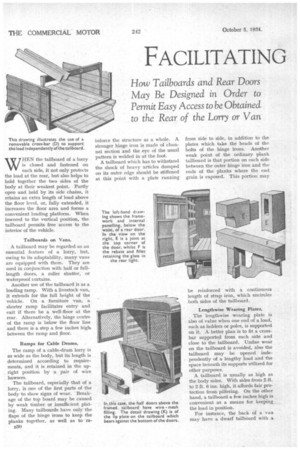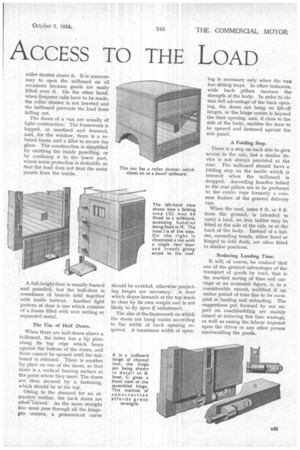FACILITATING ACCESS TO THE LOAD
Page 48

Page 49

If you've noticed an error in this article please click here to report it so we can fix it.
How Tailboards and Rear Doors May Be Designed in Order to
Permit Easy Access to be Obtained
to the Rear of the Lorry or Van WHEN the tailboard of a lorry is closed and fastened on each side, it not only protects the load at the rear, but also helps to hold together the two sides of the body at their weakest point. Partly open and held by its side chains, it retains an extra length of load above the floor level, or, fully extended, it increases the floor area and forms a convenient loading platform. When lowered to the vertical position, the tailboard permits free access to the interior of the vehicle.
Tailboards on Vans.
A tailboard may be regarded as an essential feature of a lorry, but, owing to its adaptability, many vans are equipped with them. They are used in conjunction with half or fulllength doors, a roller shutter, or waterproof curtains.
Another use of the tailboard is as a loading ramp. With a livestock van, it extends for the full height of the vehicle. On a furniture van, a shorter ramp facilitates entry and exit if there be a well-floor at the rear. Alternatively, the hinge centre of the ramp is below the floor line and there is a step a few inches higb, between the ramp and floor.
Ramps for Cable Drums.
The ramp of a cable-drum lorry is as wide as the body, but its length is determined according to requirements, and it is retained in the upright position by a pair of wire hawsers.
The tailboard, especially that of a lorry, is one of the first parts of the body to show signs of wear. Breakage of the top board may be caused by weak timber or insufficient. plating. Many tailboards have only the flaps of the hinge irons to keep the planks together, as well as to re B30 inforce the structure as a whole. A stronger hinge iron is made of channel section and the eye of the usual pattern is welded in at the foot.
A tailboard which has to withstand the shock of heavy articles dumped on its outer edge should be stiffened at this point with a plate running
from side to side, in addition to the plates which take the heads of the bolts of the hinge irons. Another weak point of the ordinary plank tailboard is that portion on each side between the outer hinge iron and the ends of the planks where the end grain is exposed. This portion may
be reinforced with a continuous length of strap iron, which encircles both sides of the tailboard.
Lengthwise Wearing Plates.
The lengthwise wearing plate is also of value when one end of a load, such as ladders or poles, is supported on it. A better plan is to fit a crossbar supported from each side and close to the tailboard. Undue wear on the tailboard is avoided, also the tailboard may be opened independently of a lengthy load and the space beneath its supports utilized for other purposes.
A tailboard is usually as high as the body sides. With sides from 2 ft. to 2 ft. 6 ins, high, it affords fair protection from pilfering. On the other hand, a tailboard a few inches high is convenient as a means for keeping the load in position.
For instance, the back of a van may have a dwarf tailboard with a
roller shutter above it. It is unnecessary to open the tailboard on all occasions because goods are easily lifted over it. On the other hand, when frequent calls have to be made, the roller shutter is not lowered and the tailboard prevents the load from falling out.
The doors of a van are usually of light construction. The framework is lapped, or mortised and tenoned, and, for the window, there is a rebated frame and a fillet to secure the glass. The construction is simplified by omitting the inside panelling, or by confining it to the lower part, where some protection is desirable, so that the .load does not dent the outer panels from the inside.
A full-height door is usually framed and panelled, but the half-door is sometimes of boards held together with inside battens. Another light pattern of door is one which consists of a frame filled with wire netting or expanded metal.
The Use of Half Doors.
When there are half-doors above a tailboard, the latter has a lip plate along its top edge which bears against the bottom of the doors, and .these cannot be opened until the tailboard is released. There is another lip plate on one of the doors, so that there is a vertical bearing surface at the point where they meet. The doors are then secured by a fastening, which should be at the top.
Owing to the demand for an attractive. outline, the back doors are ofteeCurved. As the same straight line must pass through all the hingepin centres, a pronounced curve
should be av ided, otherwise projecting hinges re necessary. A door which slopes wards at the top tends to close by i own weight and is not likely to fly 4pen if unfastened.
The size of the framework on which the doors ar hung varies according to the width of back opening required. A m1aximuin width of open ing is necessary only when the van has sliding trays. In other instances, wide back pillars increase the strength of the body. In order to obtain full advantage of the back opening, the doors are hung on lift-off hinges, or the hinge centre is beyond the door opening, and, if close to the side of the body, enables the door to be opened and fastened against the side panel.
A Folding Step.
There is a step on each side to give access to the cab, but a similar device is not always provided at the rear. The tailboard should have a folding step on the inside which is lowered when the tailboard is dropped. Ascending handles bolted to the rear pillars are to be preferred to the centre rope formerly a common feature of the general delivery van.
When the roof, some 8 ft. or 9 ft from the ground, is intended to carry a load, an iron ladder may be fitted at the side of the cab, or at the back of the body. Instead of a ladder, ascending treads, either fixed or hinged to fold flush, are often fitted in similar positions.
Reducing Loading Time.
It will, of course, be realized that one of the greatest advantages of the transport of goods by road, that is the marked saving of time and carriage at an economic figure, is, to a considerable extent, nullified if an undue period of time has to be occupied in loading and unloading. The suggestions put forward by our expert on coachbuilding are mainly aimed at reducing this time wastage, as well as easing the labour imposed upon the driver or any other person manhandling the goods.




































































































